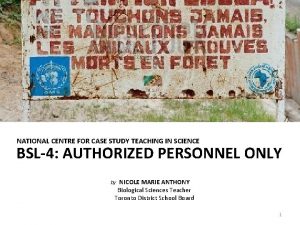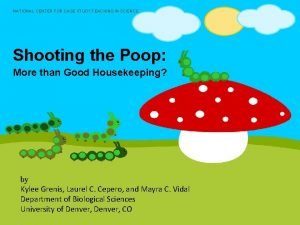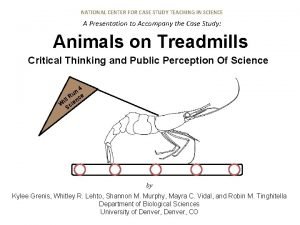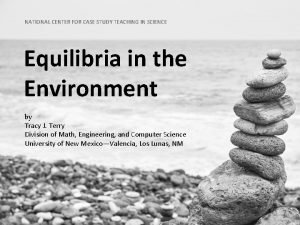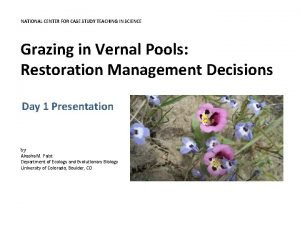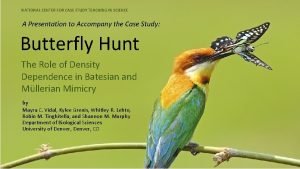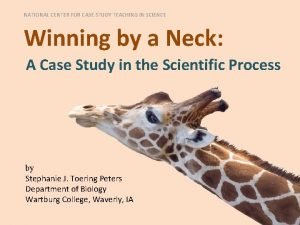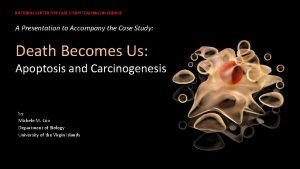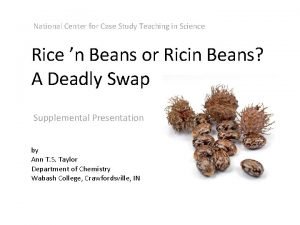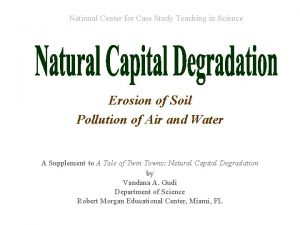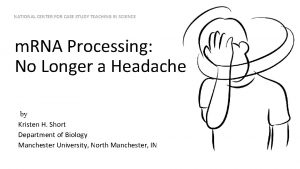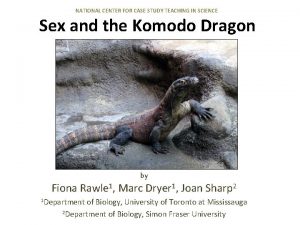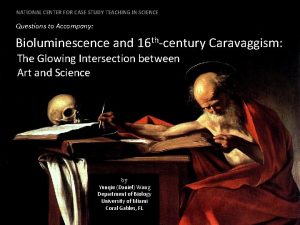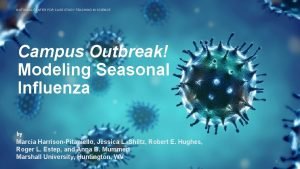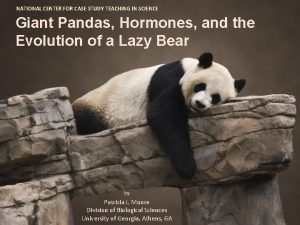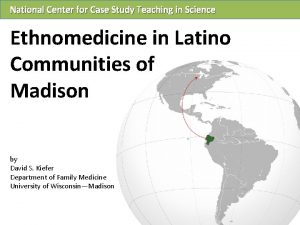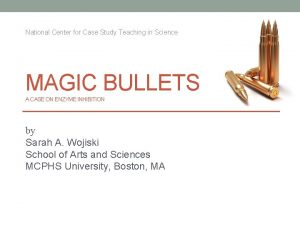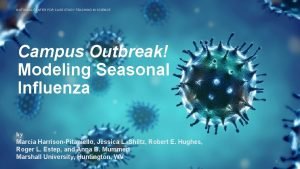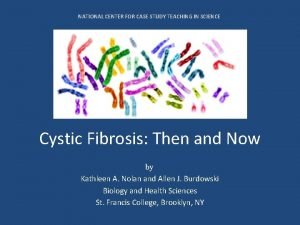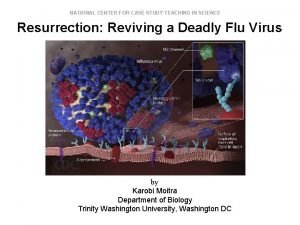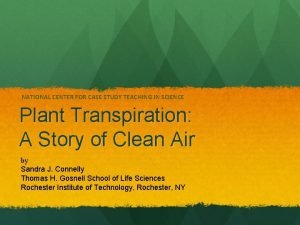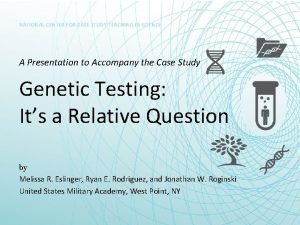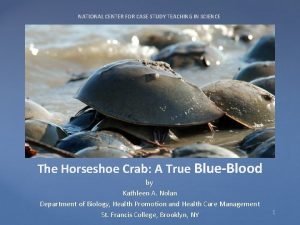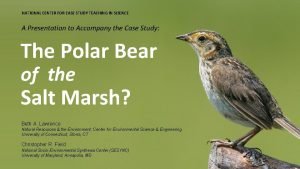NATIONAL CENTER FOR CASE STUDY TEACHING IN SCIENCE












































- Slides: 44

NATIONAL CENTER FOR CASE STUDY TEACHING IN SCIENCE The Science of Composting A presentation to accompany the case study: The Poop on Composting by Teresa C. Weglarz Department of Biological Sciences University of Wisconsin – Fox Valley

CQ#1: How much waste do you think you generate per day? A. B. C. D. 0. 5 lbs. 2 lbs. 4. 5 lbs. (the average weight of a 13″ screen laptop) 9 lbs. (about the weight of a gallon of milk or a newborn baby) 2

Municipal Solid Waste (MSW) 3

Composition of MSW ~30% is compostable + ~50% is recyclable = 80% can be diverted from landfills 4

Landfill • Nutrients from organic material not returned to the soil • Methane produced due to anaerobic decomposition • Potential for groundwater contamination 5

Law of Conservation of Matter • Matter can be transformed but cannot be created or destroyed • In natural ecosystems there is no waste • Matter is recycled and reused – Decomposers are critical in recycling 6

Biogeochemical Cycles • Abiotic reservoirs – – Atmosphere Rock Fossil fuels Ocean • Biological interactions, geologic activity and chemical reactions move nutrients through the environment • Biotic – Plants – Animals Abiotic Biotic 7

Carbon Cycle Overview • Carbon is an essential building block of biological molecules – DNA, proteins, sugars, lipids, etc. • Chemical bonds in carbon compounds provide metabolic energy 8

Photosynthesis and Cellular Respiration are Complementary 6 CO 2 + 12 H 2 O Aerobic Respiration Photosynthesis C 6 H 12 O 6 + 6 O 2 9

CQ#2: Which of the following about the cycling of carbon is false? A. CO 2 is released by all plants and animals through cellular respiration. B. All living organisms are made up of carbon. C. CO 2 is absorbed by plants through photosynthesis. D. CO 2 is a greenhouse gas. E. CO 2 is converted to glucose by cellular respiration. 10

Nitrogen Cycle • N 2 gas in the atmosphere must be fixed before it can be taken up by plants • Limiting factor in plant growth – Required for proteins and nucleic acids – Microorganisms need ~20 -30 parts of C: N 11

Nitrogen Cycle 12

Phosphorous Cycle • Phosphorous is primarily found in rock and sediment – Weathering slowly releases phosphorous • Limiting factor in plant growth – Required in cell membranes, DNA, and other compounds 13

Phosphorous Cycle Animals obtain phosphorous by eating other organisms Fertilizer & manure runoff Plants take up phosphorous from soil Weathering of rock Decomposers Burial Waste Products 14

CQ#3: Inputs of additional phosphorous from chemical fertilizers into waterways would: A. B. C. D. encourage growth of aquatic plants. lead to global warming. increase the rate of photosynthesis by plants. increase the amount of oxygen in the water. 15

CQ#4: If algae and other aquatic plants begin to die off, then: A. decomposers would decrease oxygen concentrations in the water. B. decomposers would increase oxygen concentrations in the water. C. the biogeochemical cycle of phosphorous ends. 16

Eutrophication • Excess nitrogen and phosphorous in aquatic ecosystems encourages algae growth – May lead to hypoxic water – Dead zone 17

Food Waste is a Valuable Resource Food waste is composed of: • Carbohydrates • Lipids • Proteins • Water Decomposition process breaks these macronutrients down to simpler compounds CO 2 Nutrients Organic compounds 18

CQ#5: Which one of the following is not part of a carbohydrate? A. B. C. D. Carbon Oxygen Phosphorous Hydrogen 19

CQ #6: Do you have a compost pile or bin at home? A. Yes B. No Backyard Compost Bin 20

Composting Definition • Composting is the process of biological decomposition of organic material. – The end-product of composting is compost. – Compost is a nutrient-rich material that is valuable as a soil additive. 21

Composting Trophic Pyramid Tertiary Consumers rove beetle centipede Secondary Consumers rotifer springtail nematode Primary Consumers actinomycetes fungi * * * worm slug sowbug *Detritivore – feeds on organic material and increases surface area of organic material by breaking it down Organic Matter food waste, leaves, sawdust, grass clippings 22

Microorganism Biodiversity • Compost from food waste contains a wide variety of bacteria and fungi – A gram of compost contains millions of microorganisms Bacteria Fungi Actinomycetes 100 million - 1 billion 10, 000 - 1 million 100, 000 - 100 million Responsible for most of the decomposition May appear as gray or May form long gray white colonies on web-like strands compost throughout compost and give off earthy smell 23

Critical Composting Conditions: 1. 2. 3. 4. C: N ratio Moisture Temperature Oxygen 24

C: N Ratio Material C: N ratio Paper 100 -800 Cardboard 400 -563 Straw 80 Leaves 54 Fruit 40 Coffee grounds 20 Vegetables 19 Fresh grass clippings 12 -19 Farm manure 14 • Excess of nitrogenous material can lead to production of ammonia (smelly compost) 25

CQ#7: Which of the following has the highest C: N ratio? Material Typical Chemical Composition Mixed Paper C 266 H 434 O 210 N Grass C 23 H 38 O 17 N Food Waste C 18 H 26 O 10 N A. Mixed paper B. Grass C. Food Waste 26

Moisture • Optimal moisture is ~50% – A compost pile that is too dry does not support bacteria and fungi that are necessary for decomposition • Compost should hold its shape when formed into a ball but not be so wet that water can be squeezed out – A compost pile that is too wet quickly goes anaerobic • Oxygen flow is limited 27

Temperature • Temperatures above 130°F kill most pathogens and weed seeds – Pathogens can be killed at lower temperatures but it takes longer – Temperatures that are too high can kill beneficial microorganisms • Frozen compost won’t decompose since bacteria are mostly inactive 28

Heating Up • 2 nd law of thermodynamics: disorder (or entropy) increases over time – Energy is used by organisms to maintain order – Use of energy is not 100% efficient and therefore some heat is released to the environment 29

Chemical Reactions of Composting • Microbes are workhorses of composting 6 O 2 + C 6 H 12 O 6 → 6 CO 2 + 6 H 2 C 6 H 12 O 6 + 3 SO 42 - +6 H+ → 6 CO 2 +6 H 2 O +3 H 2 S • H 2 S smells like rotten eggs C 6 H 12 O 6 → 3 CH 4 + 3 CO 2 (simplified) 30

CQ#8: Which of the following reactions would supply the greatest amount of energy to microbes? 6 O 2 + C 6 H 12 O 6 → 6 CO 2 + 6 H 2 O A. ΔG = -677 kcal/mol C 6 H 12 O 6 + 3 SO 42 - +6 H+ → 6 CO 2 +6 H 2 O +3 H 2 S B. ΔG = -107 kcal/mol C 6 H 12 O 6 → 3 CH 4 + 3 CO 2 (simplified) C. ΔG = -96 kcal/mol 31

Oxygen • Aerobic composting is the most efficient form of composting • Pile may smell if oxygen is limited • Aeration adds oxygen – Push in (blades fold up) and pull out (blades fan out) 32

Hot vs. Cold Composting Hot Composting Cold Composting • Use ~2 -3× high-carbon material to nitrogencontaining material • Add materials as they are available • Do not add weeds since the temperature will not be hot enough to kill the seeds • Does not require turning • May take a year or more – Need to add all the material at one time • Aerate to encourage growth of microorganisms • Temperature should be around 140°F-160°F for 7 -10 days 33

Compost • Finished compost has an earthy smell – A good sign that the composting process is complete is that the temperature drops • Improves soil fertility because it contains essential plant nutrients • Holds moisture and increases drought tolerance • A natural pesticide – Compost is being used instead of pesticides in some areas since pesticides have been linked to colony collapse disorder of honeybees 34

Compost ≠ Soil • Formed largely via weathering of rock • Can take up to 500 years to generate 1 inch of soil • ~50% mineral matter and 5% organic matter + air + water – Organic matter can be used up by crops and other plants • Living organisms: bacteria, fungi, worms, etc. 35

Food Waste Reduction • Composting reduces food waste but not creating food waste in the first place is preferable • A recent study found that an average American throws away $640 worth of food ever year. 36

CQ#9: Are human poop and pee valuable natural resources? A. Yes, they can be reused and recycled. B. No, they are wastes that have no economic or other value. 37

How much Feces and Urine? • Amount produced person per day – Feces: ~0. 3 lbs • 0. 3 lbs. × 300+ million people in the U. S. = ( a lot!) • May contain bacteria and other pathogens – Urine: 800 -2, 000 ml (or up to 0. 5 gal. ) • Ammonia smell is due to breakdown of urea by bacteria and is high in nitrogen • Relatively sterile • C: N ratio – Urine is 15 -19% N – Feces has a C: N ratio of 5 -10 38

Night Soil • Application of raw human waste has been common practice in Asia for thousands of years – High in N, so it is a valuable fertilizer – Concern is spread of disease – Smells bad Nutrient Cycle 39

Toilets • Most toilets use ~1. 6 gallons per flush – ~26% of household water use is for flushing the toilet – Less than 3% of water on Earth is freshwater and most of that is tied up in glaciers and ice caps – To conserve water: If it’s brown, flush it down. If it’s yellow, let it mellow. • But, where does it go? 40

Wastewater Treatment • Uses bacteria to decompose organic matter • Chlorine or UV light is used to kill pathogens • Difficult and expensive to remove N + P 41

Biosolids • Biosolids are the composted solids from wastewater treatment – Can be land applied as a fertilizer – Concern of heavy metals and other chemicals since wastewater treatment plants also process industrial wastewater • Commercially sold biosolids: – Milorganite (Milwaukee, WI) – Oshkonite (Oshkosh, WI) 42

Composting Toilet • Sun-Mar Excel $1645. 00 • Manually rotate internal drum to aerate • Liquid is evaporated • Add one cup of bulking material (peat) person per day 43

The Future • 2. 6 million people lack access to proper sanitation • Bill and Melinda Gates Foundation proposal to “Reinvent the Toilet” on-site sanitation system – Off-the-grid – Low cost – Source of revenue via resource recovery 44
 National centre for case study teaching in science
National centre for case study teaching in science National center for case study teaching in science
National center for case study teaching in science National center for case study teaching in science
National center for case study teaching in science National center for case study teaching in science
National center for case study teaching in science National center for case study teaching in science
National center for case study teaching in science National center for case study teaching in science
National center for case study teaching in science National center for case study teaching in science
National center for case study teaching in science Best case worst case average case
Best case worst case average case Foxmeyer erp failure case study
Foxmeyer erp failure case study Complete my favourite subject is
Complete my favourite subject is Microteaching cycle
Microteaching cycle Kontinuitetshantering i praktiken
Kontinuitetshantering i praktiken Typiska drag för en novell
Typiska drag för en novell Nationell inriktning för artificiell intelligens
Nationell inriktning för artificiell intelligens Vad står k.r.å.k.a.n för
Vad står k.r.å.k.a.n för Shingelfrisyren
Shingelfrisyren En lathund för arbete med kontinuitetshantering
En lathund för arbete med kontinuitetshantering Underlag för särskild löneskatt på pensionskostnader
Underlag för särskild löneskatt på pensionskostnader Tidböcker
Tidböcker Anatomi organ reproduksi
Anatomi organ reproduksi Densitet vatten
Densitet vatten Datorkunskap för nybörjare
Datorkunskap för nybörjare Boverket ka
Boverket ka Debattartikel struktur
Debattartikel struktur Autokratiskt ledarskap
Autokratiskt ledarskap Nyckelkompetenser för livslångt lärande
Nyckelkompetenser för livslångt lärande Påbyggnader för flakfordon
Påbyggnader för flakfordon Vätsketryck formel
Vätsketryck formel Offentlig förvaltning
Offentlig förvaltning Bo bergman jag fryser om dina händer
Bo bergman jag fryser om dina händer Presentera för publik crossboss
Presentera för publik crossboss Argument för teckenspråk som minoritetsspråk
Argument för teckenspråk som minoritetsspråk Kanaans land
Kanaans land Treserva lathund
Treserva lathund Epiteltyper
Epiteltyper Bästa kameran för astrofoto
Bästa kameran för astrofoto Centrum för kunskap och säkerhet
Centrum för kunskap och säkerhet Lågenergihus nyproduktion
Lågenergihus nyproduktion Mat för idrottare
Mat för idrottare Verktyg för automatisering av utbetalningar
Verktyg för automatisering av utbetalningar Rutin för avvikelsehantering
Rutin för avvikelsehantering Smärtskolan kunskap för livet
Smärtskolan kunskap för livet Ministerstyre för och nackdelar
Ministerstyre för och nackdelar Tack för att ni har lyssnat
Tack för att ni har lyssnat Referat mall
Referat mall
